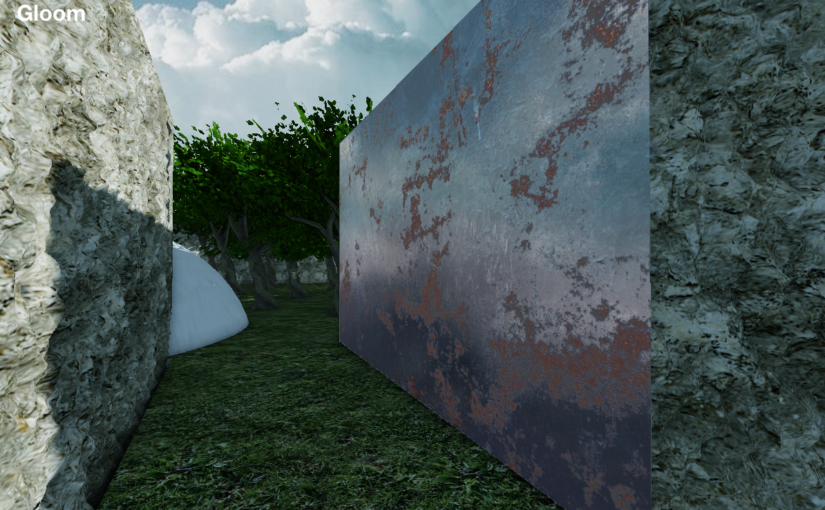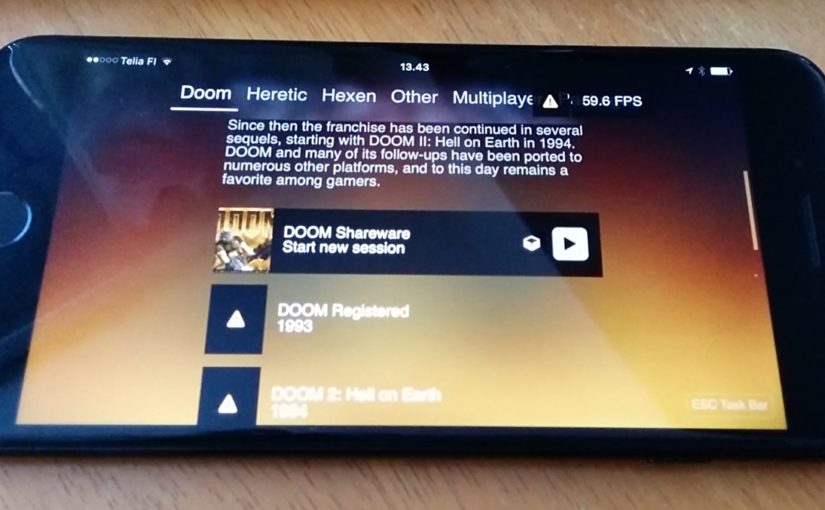During the spring I’ve been exploring the possibilities and potential directions that a completely redesigned renderer could take. Continuing from part one, this post contains more of the results and related thoughts about where things could and should be heading.
Author: skyjake
Further rendering explorations – Part 1
When it comes to graphics, things sure have changed since the beginning of the project. Back in the day — almost 20 (!) years ago — GPUs were relatively slow, you had a few MBs of VRAM, and screen resolutions were in the 1K range. Nowadays most of these metrics have grown by an order of magnitude or two and the optimal way of using the GPU has changed. While CPUs have gotten significantly faster over the years, GPU performance has dramatically increased in vast leaps and bounds. Today, a renderer needs to be designed around feeding the GPU and allowing it do its thing as independently as possible.
With so much computation power available, rendering techniques and algorithms are allowed to be much more complex. However, Doomsday’s needs are pretty specific — what is the correct approach to take here? During the spring I’ve been exploring the possibilities and potential directions that a completely redesigned renderer could take. In this post, I’ll share some of the results and related thoughts about where things could and should be heading.
Status update
The spring months have been a little crazy with various Real Life time sinks preventing me from delving too deep into fun coding. Consequently, there has been little to no progress with the tasks on the roadmap, such as the multiplayer improvements for version 2.1. Given that several months have passed, it will be challenging to find motivation to restart this work. I am tempted to make some changes to the roadmap to get things rolling along again.
I have managed to steal away some time to explore an exciting new direction for the renderer, though. The basic gist of this effort is to completely revise how the game world is drawn, bringing it up to par with the recently redone 3D model renderer.
Downloading data files from the server
To kick off the multiplayer improvements for version 2.1, I’ve started with adding access to data files over the network. For example, if a server is running a custom PWAD that you don’t have, the client will automatically download a copy before joining the game.
That pretty much sums it up for the user-facing portion of this feature. You will see a popup displaying download progress, and there is an option to cancel.
Much of this work was recently merged to the master branch (in the form of 83 commits) and is included now in unstable builds. Note that this kind of a larger influx of changes usually leads to new glitches also being introduced… I will be improving the code in the coming days/weeks.
Doomsday 2.0.3, other minor updates
Over the past few weeks, I’ve made a couple of stable builds with the version 2.0.3. The first one of those was made a bit early as I was about to leave for a trip abroad, and mainly included one bug fix for Hexen related to saving and restoring object state from save files. Recently I’ve made a couple of additional stable builds to investigate and fix a problem with the Ubuntu Launchpad build scripts, where the “doomsday-stable” packages were correctly built but nothing was actually included in the generated DEB packages.
On the whole, progress has been somewhat slow. Perhaps the biggest advance was in the dengine.net website backend, where I’ve now split the API functionality to a separate api.dengine.net server, so that things like master server and update queries won’t interfere with the normal operation of the project home page and forums. I hope this will alleviate the issue of dengine.net sometimes failing to respond to requests.
Prompted by a forum post, over the weekend I was investigating an audio volume issue on Windows. It turns out there is a problem with the SDL_mixer music volume controls. I have yet to determine if there is a workaround that Doomsday can do to avoid the issue. Such a workaround would be preferable to disabling SDL_mixer music on Windows completely, since SDL_mixer does bring value to the table (e.g., music formats). The situation is also slightly tricky because SDL and SDL_mixer are built in to the engine, so there isn’t a plugin to take out or something simple like that.
Doomsday 2.0.2 released
The stable version 2.0.2 (build 2372) is now available. The release notes can be found in the Manual.
This is another patch release that fixes incorrect behavior and improves the stability of the engine. Some of the fixes affect data file identification, so if you’re experiencing issues with your WAD files or other resources, try selecting Clear Cache from the DE menu and restarting Doomsday so that all your data is reindexed.
I recommend anyone currently running Doomsday 2 to upgrade to 2.0.2.
Odds and ends
I’ve been getting back into the swing of things with a set of smaller changes and improvements. I haven’t yet started work on the major focus of the 2.1 release, which is planned to be Multiplayer improvements.
2.0.2 will be out on Saturday, July 1st, with a couple of bugfixes that I hope will be useful. As usual, I will post the details after the build is available.
The recent changes include:
- Stability improvements. Several methods that went against the C++ standard were revised. Reliance on undefined behavior was leading to compiler optimization issues particularly with the latest GCC 7. Also, error reporting is now more robust. For instance, previously when something went wrong during busy mode (like engine startup), it could easily lead to a crash because the client app wasn’t reacting to the situation appropriately. When the error message was being shown, the application was still trying to do something in the background.
- More powerful model scripting. Starting animations and timeline scripts via Doomsday Script.
- The model renderer shaders support more macros for easier customizability. Generally speaking, using macros is more future-proof than writing completely customized shaders.
- Resource identification fixes. There was a duplicate IWAD spec for Heretic 1.3 vs. SOSR. Now only the latter remains; if you have problems with your Heretic IWADs, Clear Cache and restart Doomsday. Also, autogenerated package IDs had a problem with special characters in file names. Doomsday will choose package IDs based on the file name of the data file, however it allowed spaces and quotes be included in the IDs. This lead to problems because whitespace characters are used as separators in lists of IDs, and quotes may not be accurately escaped in Info strings. Again, Clear Cache is recommended.
- Assimp build option. There’s a new CMake build option (
DENG_ASSIMP_EMBEDDED) for disabling the use of Doomsday’s customized version of Assimp. This allows one to configure Doomsday to use the Assimp installed as a system library, which is more common on Linux for instance. - More UI tweaks. Plenty of small things:
- Minor dialog layout improvements to avoid awkward dimensions.
- Changed the UI font on Windows.
- Added popup outlines for visual clarity.
- Fixed Home tab scrolling with the mouse wheel so that it doesn’t always jump to the previously selected item when switching between tabs.
- Game icons are refreshed when package availability changes. No more missing and incorrect icons shown for game profiles.
- Fixed missing window fullscreen state notification (was affecting the appearance of the “Quit” button on Mac).
- Monitor refresh rate. Yesterday I started working on monitor refresh rate configuration options. I realized these have been completely missing from the settings for some time now. Doomsday does query the supported display modes, which includes information about refresh rates, so now you have the option of choosing which refresh rate Doomsday will prefer when switching modes on Windows/Linux (display mode changes are not done at all on macOS). However, I recommend you consider adjusting the game pixel density instead of the screen resolution to keep the UI sharp and crispy.
Notes about build 2353
I’ve been taking it easy for the past couple of weeks, but last weekend I did manage to merge the recent OpenGL changes to the master branch. Build 2353 now includes this work. Please let me know if something appears broken!
There was a slight problem with the autobuilder, so the build change log is empty. GitHub has your back, though.
Here’s a rundown of the most important changes: Continue reading Notes about build 2353
The road to mobile
I’ve spent the past couple of weeks experimenting with an iOS port of Doomsday. This is now at a proof-of-concept level and not playable yet. It isn’t quite the right time to continue much further along this path, but read on for my findings!
Doomsday 2.0.1 released
The stable version 2.0.1 (build 2311) is now available. The release notes can be found in the Manual.
This is a patch release that fixes a number of crashes and various cases of incorrect behavior. Many of the fixes are related to the new Home UI, but there are also other important improvements like faster model renderer performance.
I recommend anyone currently running 2.0 to upgrade to 2.0.1.




